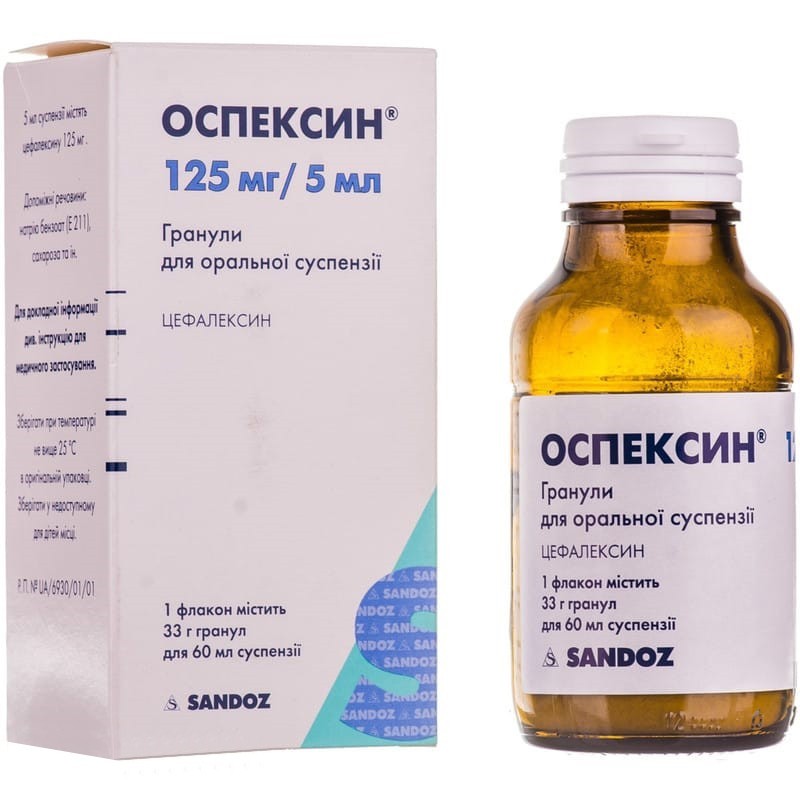



 Secure and encrypted payment processing
Secure and encrypted payment processing We ship to over 40 countries including the USA, UK, Europe, Australia and Japan
We ship to over 40 countries including the USA, UK, Europe, Australia and Japan Guaranteed refund or reship if you haven't received your order
Guaranteed refund or reship if you haven't received your orderSemisynthetic cephalosporin antibiotic of the broad-spectrum group of cephalosporins. is a derivative of 7-aminocephalosporin acid [7- (d-a-amino-a-phenylacetamido) -3-methyl-3-cephem-4-carboxylic acid]. acts bactericidal. sensitive to the drug: gram-positive microorganisms - staphylococci (coagulase-positive and penicillin-forming strains), streptococci (with the exception of enterococci, which are highly resistant to the drug), pneumococci, corynobacterium diphteriae, bacillus subtilis, bacterioides melanin; gram-negative microorganisms - e. coli, salmonella spp., shigella spp., neisseria spp., proteus mirabilis, haemophilus influenzae (about 75% of strains), klebsiella pneumoniae (about 50% of strains), treponema pallidum and actinomycetes.
Quickly absorbed by oral administration; ingestion does not affect the absorption of the drug. Oral bioavailability is over 90%. The peak concentration in blood serum is reached no later than 60–90 minutes after oral administration of the drug. Cephalexin penetrates well into tissues and body fluids, including pericardial and pleural membranes. Only 10-15% of the active substance binds to plasma proteins. The half-life is about 50 minutes. The drug is excreted mainly in urine (most of it is in active form).
Urinary tract infections, including prostatitis caused by e. coli, pr. mirabilis, klebsiella spp. infections of the skin and subcutaneous adipose tissue, including those caused by staphylococci and / or streptococci. infections of bone and connective tissue, including osteomyelitis caused by staphylococcus and / or pr. mirabilis. respiratory tract infections, including those caused by s. pneumoniae, beta-hemolytic streptococcus group a. otitis media, pharyngitis caused by s. pneumoniae, h. influenzae, staphylococci, streptococci and neisseria catarrhalis. in dentistry - in cases of diseases caused by staphylococci and / or streptococci. the drug is used as a continuation of therapy after parenteral administration of cephalosporins.
Take orally, regardless of the meal.
Adults: daily dose for infections caused by sensitive (gram-positive) microorganisms - 1–4 g; for infections caused by weakly sensitive microorganisms (gram-negative): 4-6 g or more, divided into 2, 3 or 4 doses. The minimum daily dose is 1 g.
Children: the daily dose for infections caused by susceptible microorganisms is 25-50 mg / kg body weight, divided into 2, 3 or 4 doses. The daily dose for infections caused by less sensitive microorganisms is up to 100 mg / kg body weight. It is not recommended for newborns and children to prescribe a dose above 100 mg / kg body weight per day; adolescents and adults - no more than 4 g / day.
Recommended suspension dosage:
Children under the age of 1 year: 1 scoop (5 ml) of a suspension of 125 mg / 5 ml (3-4 times a day) or1/2 scoops of suspension 250 mg / 5 ml (3 times a day).
Children aged 1 year –3 years: 1 scoop of suspension 250 mg / 5 ml 3 times a day.
Children aged 3–6 years: 11/2 measuring spoon suspension 250 mg / 5 ml 3 times a day.
Children aged 6-10 years: 2 scoops of suspension 250 mg / 5 ml 3 times a day.
Adolescents 10-14 years: 2 scoops of suspension 250 mg / 5 ml 3-4 times a day.
For uncomplicated infections of the genitourinary tract, infections of the skin and soft tissues, or streptococcal pharyngitis, the daily dose can be divided into 2 doses with an interval of 12 hours. In the treatment of otitis media, a dosage of 75-100 mg / kg body weight has been clinically proven.
Ospexin treatment should be continued for another 2–5 days after the disappearance of the symptoms of the disease. For the prevention of complications of streptococcal infections, the drug is taken for at least 10 days.
Hypersensitivity to cephalosporins. in the treatment of patients with hypersensitivity to penicillins, the possibility of cross-allergy (about 5-10%) should be considered.
Diarrhea, headache, general weakness, tremor, dizziness, eosinophilia and neutropenia, stomatitis are possible. with diarrhea while taking the drug, the possibility of developing pseudomembranous colitis should be considered. in isolated cases, hypersensitivity reactions develop, the course of which, as a rule, is mild and disappearing over several days. in extremely rare cases, systemic reactions (including anaphylactic shock), sporadic cases of interstitial nephritis are possible.
Ospexin is prescribed with caution in patients with increased sensitivity to penicillins. with a hypersensitivity reaction, the use of adrenaline, antihistamines and corticosteroids is indicated.
Before using the drug, a bacteriological study should be carried out.
In patients with impaired urinary function during treatment, it is necessary to control renal function, with prolonged use of the drug - liver function and blood counts.
When examining the urine of patients receiving the drug, they can determine false-positive results of the reaction to glucose, if the determination is made using copper-containing reagents or by the direct antiglobulin method (Coombs reaction).
To prepare a suspension for oral administration, fill the vial with drinking water up to half, shake well and add water to the annular mark on the vial. Shake well before use.
During pregnancy and breastfeeding. There are no data on embryotoxic, teratogenic, mutagenic effects of cephalexin. Ospexin passes into breast milk.
Given the bactericidal effect of ospexin, it should not be used simultaneously with bacteriostatic antibiotics (e.g. tetracyclines, chloramphinecol).
When combined with highly active diuretics (ethacrylic acid, furosemide) or potentially nephrotoxic antibiotics (aminoglycosides, polymyxin, colistin), cephalosporins can enhance nephrotoxicity.
With a combination of cephalosporins with oral anticoagulants, prolongation of prothrombin time is possible.
Granules for suspension are stored in a dry, dark place at temperatures up to 25 ° c. the finished suspension remains stable for 14 days in a dark and dry place at temperatures up to 25 ° c.